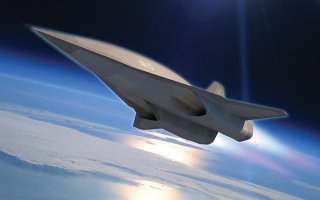Imagine a Supersonic Air Force One. (It Could Happen.)
A realistic concept, or is a supersonic Air Force One just a pipe dream?
Here's What You Need To Remember: The Air Force announcement is somewhat surprising considering the work that is already being done on the newest upcoming Air Force One generation. Still, as far as reviving supersonic travel goes, this attempt might be the most serious. Watch this topic for developments in the future.
The Air Force is putting money into a supersonic VIP plane that could shuttle around at nearly double the speed of sound.
In a tweet, the Air Force Life Cycle Management Center announced that Exosonic, an aerospace company, was awarded a contract to “develop a low-boom supersonic executive transport aircraft that will allow key decision makers and teams to travel around the world in half the time it takes now!” In the image that accompanied the tweet, an artistic rendering of a supersonic airplane could be seen, painted in the typical sky blue and white Air Force One livery. But is a supersonic Air Force One a pipe dream?
Air Force One
Under the direction of President Trump, the Air Force is currently building a new pair of Air Force One airplanes. These two airframes, originally intended as cargo transports, are modified 747-8is. Although the 747-8is are Boeing’s most advanced 747 variant, capable of flying at Mach .855, they are in most other respects very conventional.
One of the quirks of the design is the paint scheme. Rather than opting for the traditional sky-blue and white livery pioneered by President John F. Kennedy, the new Trump-designed airframes opt for a red, white, and blue design that is incredibly similar to the executive planes that ferried Trump around prior to becoming president.
Speed of Sound
Commercial supersonic flight is nothing new. Both Russia and the United States tried to develop their own answer to the French-British Concorde, though both projects were failures. The Concorde was not a perfect platform either.
Flying at over double the speed of sound meant that the Concorde’s four engines needed fuel, lots of fuel. The gas-guzzling platform was decidedly un-green. The delta-wing design was also incredibly loud. When flying over populated areas, Concordes were required to reduce airspeed in order to cause less disturbance on the ground. This was perhaps their most significant drawback—and one that Exosonic hopes to remedy.
Exosonic
The company website summarizes what their goal is rather succinctly: “We are building a quiet, Mach 1.8 70-seater supersonic passenger aircraft that can fly supersonically overland and overwater with a muted sonic boom.” The company hopes to revive commercial supersonic aviation with an eye on high-speed passenger and cargo travel.
The company’s current supersonic design is at least outwardly somewhat similar to the X-59, one of the fabled X-series of prototype aircraft used by the Air Force and NASA for research and development purposes. The X-59, and Exosonic’s airframe appear to try and mitigate or reduce sonic boom thanks to a long and sharply-pointed nose cone and elongated fuselage.
Postscript
The Air Force announcement is somewhat surprising considering the work that is already being done on the newest upcoming Air Force One generation. Still, as far as reviving supersonic travel goes, this attempt might be the most serious. Watch this topic for developments in the future.
Caleb Larson is a defense writer with the National Interest. He holds a Master of Public Policy and covers U.S. and Russian security, European defense issues, and German politics and culture. This article first appeared earlier this year.
Image: Reuters.

